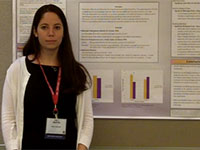Monkeys Might Be More Logical Than We Think
You see a big cat nursing a kitten, and you assume Cat A is Cat B’s mother. Then you see a bird dropping worms in a smaller bird’s mouth. Different content, different context, but same relationship—you conclude that Big Bird is Little Bird’s mom. This is an analogy—a relationship between relationships.
What is behind this ability—and is it uniquely human? “There is a long debate as to whether this ability is dependent on language,” says Center for Research in Cognitive Neurosciences and University of Provence cognitive psychologist Joël Fagot. “It has been shown in apes who have been language trained.”
But can animals perceive analogies without language? Now, two scientists—Fagot, who and Roger Thompson of Franklin & Marshall College—have answered with an incontrovertible yes. Their findings are published in Psychological Science, a journal of the Association for Psychological Science.
Twenty-nine baboons were given a “relational matching to sample” (RMTS) task to learn. First, two shapes appeared on a screen, which were either identical or different. When the baboon touched the screen, the pair was replaced by two pairs of new shapes, one pair identical, one not. The monkeys had to touch the pair that had the same relationship—identical or non-identical—as the first pair. A correct answer won some wheat pellets.
A second task was similar to the first, except that when the second screen came up, not all the shapes were novel. One was repeated from the first screen. Say there were two triangles on the first screen; the second screen might contain a triangle-circle pair and a square-square pair. If the monkey chose the triangle and circle, he was responding to the shape, not the relationship between the shapes. He was not perceiving an analogy.
The trials were presented in groups of 100, which the monkeys worked at will inside boxes accessible to their outdoor group living quarters.
Over about two months, and hundreds of thousands of trials, six of the 29 animals mastered the first task to a success rate of 80%; five learned the second. A year later, the successful baboons got both tasks to learn again. They did, with far fewer tries: For instance, one monkey who took 179 sets of 100 trials on the first go-round took only 39 after a year. Another, who’d needed 154, aced the task in 17. Fagot and Thompson’s conclusion: Language-naïve animals can retain their ability to see analogies over a long time—a capability they see as evolutionarily adaptive.
Fagot attributes the success of the experiment to the unique setup. The animals worked by themselves, coming and going as they please, repeating the task an enormous number of times, and without the potentially confounding effects of human interaction.
The implications of these findings are broader than the lives of baboons. Says Fagot: “The real question is ‘What is thinking without language?’” Without words, can creatures process the things they see and accomplish cognitively challenging tasks? These brand-new findings, he says, “suggest there is thinking without language.”




APS regularly opens certain online articles for discussion on our website. Effective February 2021, you must be a logged-in APS member to post comments. By posting a comment, you agree to our Community Guidelines and the display of your profile information, including your name and affiliation. Any opinions, findings, conclusions, or recommendations present in article comments are those of the writers and do not necessarily reflect the views of APS or the article’s author. For more information, please see our Community Guidelines.
Please login with your APS account to comment.